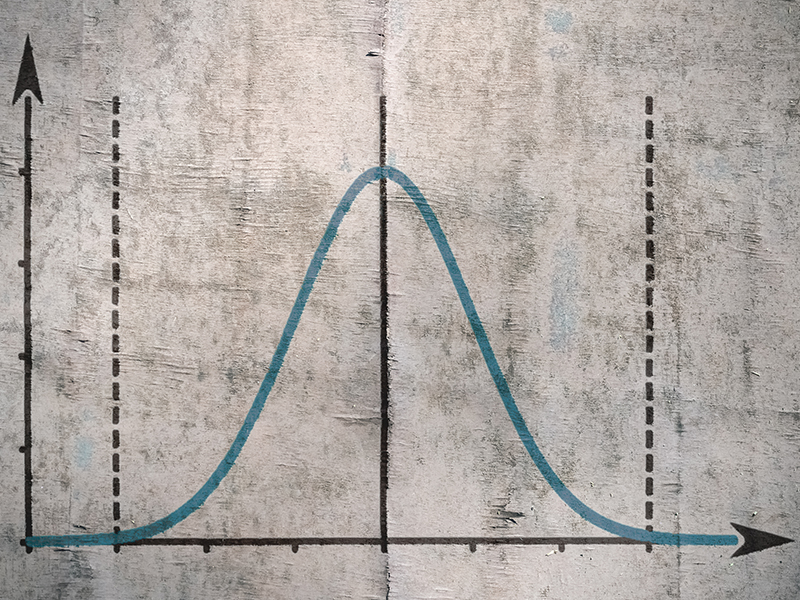
I’ve played “WHAT IF?” with a bell curve as a metaphor for many years because it offers a framework that helps inform, challenge or resolve my thoughts/feelings about issues. There’s a reason this blog topic is being published on Equinox which I’ll share at the end. I’ll also explore these five of the most challenging and enlightening “WHAT IF?” bell curves for me.
- Grading
- Wealth Distribution
- Sins and Virtues
- MBTI scales and national cultural bias
- Male and Female

What is a Bell Curve?
The teacher that introduced this idea to me as a grade schooler taught it physically by having us stand in a line with the tallest person on one end and the shortest person on the other. We were to position ourselves along the line in terms of height. Most of us were towards the middle, including a cluster of five the same height just to the right of the middle of the line. Once we organized ourselves we individually came to stand by the teacher and look at what we’d made.
Then we changed it by putting the two tallest people in the middle and the two shortest on both ends. The rest of us chose one side or the other, generally near best friends. Because of this experience I understood from the beginning the bell curve represented what you asked it to represent: changing what you asked it to represent changed where you stood (different criteria). And we would stand in different places given different criteria (different standard distribution).
Here’s one formal definition of a bell curve if you want to read it:
The term “bell curve” is used to describe a graphical depiction of a normal probability distribution, whose underlying standard deviations from the mean create the curved bell shape. A standard deviation is a measurement used to quantify the variability of data dispersion, in a set of given values around the mean. The mean, in turn, refers to the average of all data points in the data set or sequence and will be found at the highest point on the bell curve.
I chose Investopedia’s definition because it includes this comment in Limitations of a Bell Curve:
Sometimes there is skewness, or a lack of symmetry, between what falls above and below the mean. Other times there are fat tails (excess kurtosis), making tail events more probable than the normal distribution would predict.
Grading and a Tail Bell Curve
The example of Grading students is first because it was my first confrontation of the idea. In the years of teaching at universities/colleges I gave up grading on bell curves, even when threatened by an administration that I will “bell curve” the students in my classes or else. I began a class by saying, “You all have A grades at this moment. This is how you keep the A…” and I defined the rules:
- Show up for Class (we did roll call questions and answers).
- Participate in Discussion (I called on the introverts to balance the discussion).
- Do the Assignments on Time (or talk to me ahead of time).
- Redo the Assignment working with my comments and me until it is A work.
Then I said, “If at any point you find you can’t do these things, drop the class.”
Two to five students would drop the class (one tail of a standard bell curve now absent). Some did most of it (C or B) and the rest As (a fat tail). When I defended my method to administrations I’d ask for their reasons for forcing me to meet a bell curve. Responses were unreasonable or disturbing, and when expressed out loud by the administrators at times caused them to reconsider. What we want is an (excess kurtosis), an A-for-all-making tail.
The WHAT IF? I entertain is if we stopped grading would we more readily recognize, appreciate and teach to differences in approaches to learning? When I joined the Training and Development department in a utility corporation grading was no longer an issue. The goal was to educate every employee.
Wealth Distribution Bell Curves
I am an amused reader of Bill Bonner, a conservative financial advisor and author. His often cynical comments make me laugh. We disagree on about everything, which is why I read him. But on the distribution of wealth in the USA we agree. In a recent column titled, What Kind of Morons are We, Bonner uses median and average on a bell curve to make this point:
Yesterday, when we looked up the median hourly wage in 2023, we got $11. Today, we get–from the ListFoundation–$16 and change. The average wage … includes the salaries of Wall Street executives and sports stars. It’s over $28 per hour. But it is irrelevant. The median actually measures what most people get….
And we learn “Wages, adjusted for inflation, have not gone up in more than half a century.” For us any bell curve on earned wages is flat.
I unsuccessfully went to Wikipedia to find a bell curve of the distribution of wealth, which would demonstrate the inequality of wealth distribution. I did find a useful collection of USA data: https://en.wikipedia.org/wiki/Distribution_of_wealth. It’s hard to represent this astounding information in a bell curve. From Wiki:
In the first quarter of 2023: (Jul 17, 2023 search Distribution of Wealth in USA)
-
-
- 69% of the total wealth in the United States was owned by the top 10% of earners.
- The lowest 50% of earners owned 2.4% of total wealth.
-
Economists Bonner quotes say this issue cannot adjust itself to a more equitable distribution without intervention. WHAT IF? we decided on a basic income level that guaranteed for all housing, food, child care and schooling through college or trade school. With basics provided people would be able to earn, pay taxes, and then invest (like the 1% who have so much more to invest and so become more and more wealthy).
Sin and Virtue
I earned an MA in Chaucer with the intention of going on for a Ph.D. in medieval studies and becoming a university teacher. I didn’t follow that path (I’m happy about that), but Chaucer remains a very important person and author to me. In two previous blogs, The Middle Way to Transformation and Chaucer & Free Will, I talk about the seven bell curves of Sins and Virtues.
The WHAT IF? is to consider what would transform in us, and our relationships, if we understood the Middle is place where that happens, not at the ends. We spend our lives seeking balance between the two tails or ends, neither debauched nor holy, but human.
Myers/Briggs (MBTI) Scales and National Cultural Bias
For those many of us for whom the MBTI remains a useful analysis, the four scales are often described as a bell curve with many people in the center rather than at the extremes (this would mean they positively recognized behaviors on both sides of the scale).
The United States is primarily Extroverted (look at TV ads). Introverted behavior is judged negatively. Sensing folk (step by step, right now oriented) are more prominent than intuitives (big picture, future oriented). Decision-making used to be scored by adding 1 point to the Feeling (value decider) scale for men because they were so conditioned to be Thinking (Logic).
India is dominantly intuitive, and so any sensing person finds the lack of things that actually work appalling, and monotheists are disturbed by the multitude of holy beings.
Japan is introverted (extroverts suffer cultural bias), and we’ve observed many people are embarrassed when something doesn’t work or run exactly on time.
This WHAT IF? bell curve is a game for me, not scientific research. However, What If we lived in a world that allowed us to make room in ourselves for our own and others’ preferences? WHAT IF we made room in our view of the world to explore why another culture is different and what is at risk if they conform to our view of the world?
Male & Female
When I teach Greek Archetypes the first part of the class is learning the different archetypes’ characteristics using the Greek Gods and Goddesses, each of whom embodies a specific archetypal energy. For the Greeks, Jean Shinoda Bolen’s Goddesses/Gods in Every Woman/Man books are useful. Bolen uses the image of various Gods/Goddesses sitting around a dining room table, and then asks, “Are you sitting at the head of the table?” That is the traditional position of the host or hostess, who is responsible for facilitating the conversation and table dynamics.
One exercise:
- People partner so each one can lie down on a butcher paper sheet while the other traces the body outline on the paper.
- Each person takes their own outline and decorates it to represent the Archetypes whose characteristics and qualities are in their own person.
- We hang these drawings as high up on the wall as possible, giving a sense of the overpowering possibility of the archetypes. (“Who is at the head of the table?)
- People describe what they drew.
One woman might choose Aphrodite for her exterior presentation but Hestia (goddess of hearth and home) for her heart. A man might choose Aries (Mars – God of War) for his exterior but Hephaestus (Hades – God of the Underworld) for his mid-section.
Since the group was learning both male and female archetypes there were often times when a person would recognize both male and female archetypes in themselves. Four examples:
- Hestia (hearth and home) exterior, Zeus (head) and Athena (heart) interior characteristics
- Apollo exterior, Artemis interior (interesting because these two are twins (Sun and Moon) archetypes)
- Aphrodite exterior, interior Hermes (Mercury) heart, Ares (Mars) arms and legs (“to defend myself”)
- Ares exterior body/Zeus head with interior Hestia body/Apollo heart
A bell curve metaphor could place Masculine at one end and Feminine at the other. The ends of this Gender bell curve have been described for decades (probably centuries) with culturally preferred characteristics. In the USA:
Male—a person with dominant traits: Ares/Mars (warrior), Zeus (CEO of Gods), Helios/Apollo (Enlightenment).
Over the centuries Dionysus often has been downgraded to drunkard (bacchanalian), Hephaestus (Hades) and Pan to the devil, Poseidon to extreme emotions, Cronos to bad father, Eros to sex, Hermes/Mercury to telegrams.
I do not think there is a skew on the curve towards this dominant male description. I think of the thousands of men working in the military or corporations or running their own shops who are kind, curious, caring, and also suppressed by domination. I think of two generations of new fathers who tend their children (and help with housework).
Female—a person with separate, preferred or mocked/persecuted characteristics: Hera (wife), Demeter (mother. Earth), Persephone (daughter), Aphrodite (whore), Hestia (old maid), Athena (wisdom/politics), Artemis (warrior virgin), Hecate (witch).
If Barbie dolls could be a representation of one end of the female bell curve, it heartens me to see their development over the decades. The definition of feminine has expanded. Barbie can be a professional now. Women can be lawyers (Athena) and Aphrodite can include role models like Dolly Parton, who is a literacy champion.
WHAT IF? people were free to stand anywhere on the Gender bell curve? Would most of us cluster in the middle? If so, WHAT IF? we realized the far ends as extreme positions? WHAT IF? there were no taboos? WHAT IF? there was no intense conditioning worldwide?
LGBTQIA+
We live in a time when the evolving acronym LGBTQIA+ currently stands for lesbian, gay, bisexual, transgender, queer/questioning, intersex, asexual. On our bell curve would folks choose to stand in the middle of a bell curve lineup?
Bill Bonner (referenced above) describes recently, to my annoyance, how males were, are, and will be competitors like cocks in a fight. And women want the dominant male. This is because their primary drive is offspring. Period. No room for difference.
WHAT IF? the reality is that most of us are in the middle of both expression of gender and possibly biologically?
Human beings are not the only creatures with homosexual behavior. Recently I read an article in Scientific American on a lesbian monkey triangle that contained this statement: “same-sex behavior,” … is something that’s now been documented in more than 1,500 different species.
I checked that comment in Wikipedia: “homosexual behavior is found amongst social birds and mammals” and gives a list of those and other species. A new article summarizes three possible WHAT IF? biological scientific explanations.
If I WHAT IF? that most of us may be in the middle of the gender bell curve, and if raised in a culture without intense conditioning and taboos, might be either depending on the circumstance, how would that change our cultures worldwide?
WHAT IF we raise children and relate to people without blaming, hating, commenting
WHAT IF we just let a person develop and be…
WHAT IF there was much less perversion?
WHAT IF birth rates in this overcrowded world dropped?
WHAT IF…

Autumn on the Seine, Argenteuil, Claude Monet, 1873
Why Choose A Topic of Bell Curves for Equinox?
Equinox is a physical embodiment of the center of a line of light when one end of a timeline is Summer Solstice Most Light and the other Winter Solstice Least Light. Days of equal light between the two ends are in the middle and called the two seasons of Equinox (Spring and Fall Equinox). Planet wide it is the moment when night and day are equal, and the planet is centered.
My WHAT IF? Can Equinox teach us that when we find ourselves in some bell curve, we can stand for a Solstice Skew for justice (e.g., Skew of grades to A) or put ourselves in the center (Equinox position), where we are balanced, centered and whole.
Holy Equinox, hold us in balance. Teach us the virtue of a centered position.
May these few days be full of light, and these nights dark except for the stars.
Let us be privileged to explore any WHAT IF? without conditioned bias.
Bless us as we go about our autumn tasks and joys.






Thanks Lola! Reading this Blog is a wonderful to start to Equinox for me this year. I’m reading Iain McGilcrist’s “The Matter With Things” about the need to balance our Right and Left Hemispheres (of the brain and of society), making Life’s Balance a matter of Both, And….. vs Either/Or. (I’m not doing justice to his books by saying this, it’s much richer than these binary descriptions), but I share this in order to mention the synchronicity of reading your Blog today. Blessing!
I received a couple of emails saying they thought the blog was perfect for Equinox as well. As I was a little worried people might think it didn’t fit I’ve been delighted by these comments!
I found moving from Either/Or to Both/And useful in both my own thinking (and feeling) and in group facilitation. Something in us relaxes when we remember we have a corpus callosum linking the brain hemispheres. If we could use Both/And in our family to international discussions we could gain so much for so many. Both/And respects diversity of thought, and fosters resilience. More about resilience in the next (Oct 14) blog.
Having worked in the theatre and having taught creative writing, the question, “What if?” is always useful for stimulationg ideas and alternate ways of thinking. ALthough I taught for more than 60 years I never used a Bell Curve, nor was I ever asked to use one. To me, it’s an idea that doesn’t translate to real situations. When I taught in the Honors Program, students’ work was always of high caliber; no way would a Bell Curve fit the actual situation. The “What If” that resonates with me is “What If we really treated people as individuals with unique capabilities, qualities, and experiences rather than algorithms or Bell Curves or conglomerates?
Nancy, thanks for sharing your experiential commitment to teaching people as unique, worthy individuals.
I know from some of our conversations that your students were challenged and flourished, each in different ways.
The teachers I learned the most from asked “What if…” questions. Some of them I still wonder about. (What if Hamlet had lived?)